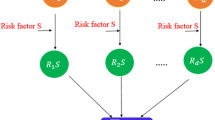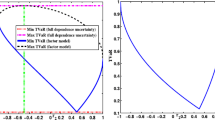Abstract
Measures of risk concentration and their asymptotic behavior for portfolios with heavy-tailed risk factors is of interest in risk management. Second order regular variation is a structural assumption often imposed on such risk factors to study their convergence rates. In this paper, we provide the asymptotic rate of convergence of the measure of risk concentration for a portfolio of heavy-tailed risk factors, when the portfolio admits the so-called second order regular variation property. Moreover, we explore the relationship between multivariate second order regular variation for a vector (e.g., risk factors) and the second order regular variation property for the sum of its components (e.g., the portfolio of risk factors). Results are illustrated with a variety of examples.
Similar content being viewed by others
References
Alink, S., Löwe, M., Wüthrich, M. V.: Diversification of aggregate dependent risks. Insurance Math. Econom. 35(1), 77–95 (2004)
Barbe, P., Fougères, A. L., Genest, C.: On the tail behavior of sums of dependent risks. Astin Bull. 36(2), 361–373 (2006)
Bingham, N. H., Goldie, C. M., Teugels, J. L.: Regular variation encyclopedia of mathematics and its applications, vol. 27. Cambridge University Press, Cambridge (1989)
Bürgi, R., Dacorogna, M., Iles, R.: Risk aggregation, dependence structure and diversification benefit. In: Stress testing for financial institutions, pp 265–306. Risk Books, Incisive Media, London (2008)
Dacorogna, M., Elbahtouri, L., Kratz, M.: Model validation for aggregated risks. Ann. Actuarial Sci. 12(2), 433–454 (2018). 10.2139/ssrn.2716093
Degen, M., Embrechts, P.: Scaling of high-quantile estimators. J. Appl. Probab. 48(4), 968–983 (2011)
Degen, M., Lambrigger, D., Segers, J.: Risk concentration and diversification: Second-order properties. Insurance: Math. Econ. 46(3), 541–546 (2010)
Embrechts, P., Klüppelberg, C., Mikosch, T.: Modelling extreme events for insurance and finance. Springer-Verlag, Berlin (1997)
Embrechts, P., Lambrigger, D., Wüthrich, M.: Multivariate extremes and the aggregation of dependent risks: Examples and counter-examples. Extremes 12(2), 107–127 (2009)
Embrechts, P., McNeil, A., Straumann, D.: Correlation and dependence in risk management: Properties and pitfalls. In: Dempster, M. A. H. (ed.) Risk management: Value at risk and beyond, pp 176–223. Cambridge University Press, Cambridge (2002)
Geluk, J., de Haan, L.: Regular Variation, Extensions and Tauberian Theorems CWI Tract, vol. 40. Stichting Mathematisch Centrum, Centrum voor Wiskunde en Informatica, Amsterdam (1987)
de Haan, L.: On regular variation and its applications to the weak convergence of sample extremes. Mathematical Centre Tracts Vol. 32 (1970)
de Haan, L., Ferreira, A.: Extreme value theory: An introduction. Springer-Verlag, New York (2006)
de Haan, L., Resnick, S.: Estimating the limit distribution of multivariate extremes. Commun. Stat. Stoch. Model. 9(2), 275–309 (1993)
de Haan, L., Stadtmueller, U.: Generalized regular variation of second order. J. Aust. Math. Soc. Series A 61(3), 381–395 (1996)
Hua, L., Joe, H.: Second order regular variation and conditional tail expectation of multiple risks. Insurance: Math. Econ. 49(3), 537–546 (2011)
Ibragimov, R., Jaffee, D., Walden, J.: Diversification disasters. J. Financ. Econ. 99(2), 333–348 (2011)
Kortschak, D.: Second order tail asymptotics for the sum of dependent, tail-independent regularly varying risks. Extremes 15(3), 353–388 (2012)
Kratz, M.: Normex, A new method for evaluating the distribution of aggregated heavy tailed risks. application to risk measures. Extremes. Special issue on Extremes and Finance 17(4), 661–691 (2014)
Mao, T., Hu, T.: Second-order properties of risk concentrations without the condition of asymptotic smoothness. Extremes 16(4), 383–405 (2013)
Neveu, J.: Mathematical foundations of the calculus of probability. Translated by Amiel Feinstein. Holden-Day, Inc. San Francisco, Calif.-London-Amsterdam (1965)
Omey, E., Willekens, E.: Second order behaviour of the tail of a subordinated probability distribution. Stoch. Process. Appl. 21(2), 339–353 (1986)
Peng, L., Wang, R., Yang, J.: Bounds for the sum of dependent risks and worst value-at-risk with monotone marginal densities. Finance Stochast. 17(2), 395–417 (2013)
Puccetti, G., Rüschendorf, L.: Sharp bounds for sums of dependent risks. J. Appl. Probab. 50, 42–53 (2013)
Resnick, S.: Hidden regular variation, second order regular variation and asymptotic independence. Extremes 5(4), 303–336 (2002)
Resnick, S.: Heavy tail phenomena: Probabilistic and statistical modeling. Springer series in operations research and financial engineering. Springer-Verlag, New York (2007)
Resnick, S.: Extreme values, regular variation and point processes. Springer Series in Operations Research and Financial Engineering. Springer, New York (2008). Reprint of the 1987 original (2008)
Sun, Y., Li, H.: Tail approximation of value-at-risk under multivariate regular variation. Int. J. Oper. Res. (Taichung) 7(4), 34–44 (2010)
Tasche, D.: Capital allocation to business units and sub-portfolios: The Euler principle. In: Resti, A. (ed.) Pillar II in the new basel accord: The challenge of economic capital, pp 423–453. Risk Books, Incisive Media, London (2008)
Tong, B., Wu, C., Xu, W.: Risk concentration of aggregated dependent risks: The second-order properties. Insurance: Math. Econ. 50(1), 139–149 (2012)
Vervaat, W.: Functional limit theorems for processes with positive drift and their inverses. Zeitschrift für Wahrscheinlichkeitstheorie und Verwandte Gebiete 23, 245–253 (1971)
Acknowledgments
Both authors are grateful to the referees, including the associate editor, for their insightful reviews of the manuscript and many helpful suggestions.
Author information
Authors and Affiliations
Corresponding author
Additional information
Publisher’s note
Springer Nature remains neutral with regard to jurisdictional claims in published maps and institutional affiliations.
Bikramjit Das gratefully acknowledges partial support from MOE2017- T2-2-161. Partial support from RARE-318984 (an FP7 Marie Curie IRSES Fellowship) is kindly acknowledged by both authors.
Appendix
Appendix
The diversification property relating the marginal risks to the aggregate risk in Theorem 3.4(2.a), can be easily extended to tail equivalent risks. We provide the result in the following.
Theorem 6.1
Let \(X\in 2\mathcal {RV}_{-\alpha ,\rho _{X}}(b_{X},A_{X},H_{X})\) and \(Y\in 2\mathcal {RV}_{-\alpha ,\rho _{Y}}(b_{Y},A_{Y},H_{Y})\) with α > 0,ρX < 0,ρY < 0 and
Assume that X and Y are tail equivalent risks, meaning that \(\displaystyle 0<\lim _{t\to \infty } b_{X}(t)/b_{Y}(t)<\infty \), and define \(\displaystyle \tilde {K}_{d}:=\lim _{t\to \infty } \frac {b_{Y}(t)}{d b_{ X}(t)}\). Then the following hold.
-
i.
If \(\displaystyle {\lim _{t\to \infty }A_{X}(b_{X}(t))/A_{Y}(b_{Y}(t)) =\kappa \in \mathbb {R}}\), then, for any x > 0, we have
$$ \begin{array}{@{}rcl@{}} \lim_{t \to \infty} \frac1{ A_{Y}(b_{Y}(t))}\times\left( \frac{\text{VaR}_{1-x/t}(Y)}{d \text{VaR}_{1-x/t}(X)} - \tilde{K}_{d}\right) = \frac{(c_{Y}-\kappa c_{ X})\tilde{K}_{d}}{\alpha\rho_{Y}} (x^{{-\rho_{Y}/\alpha}}-1). \end{array} $$ -
ii.
If \(\displaystyle {\lim _{t\to \infty }A_{Y}(b_{Y}(t))/A_{X}(b_{X}(t)) =0}\), then, for any x > 0, we have
$$ \begin{array}{@{}rcl@{}} \lim_{t \to \infty} \frac1{ A_{X}(b_{X}(t))}\times\left( \frac{\text{VaR}_{1-x/t}(Y)}{d \text{VaR}_{1-x/t}(X)} - \tilde{K}_{d}\right) = -\frac{c_{X}\tilde{K}_{d}}{\alpha\rho_{X}} (x^{{-\rho_{X}/\alpha}}-1). \end{array} $$
Proof
The proof of Theorem 6.1 is the same as that of Theorem 3.4(2.a) and can be obtained by replacing X1 by X, Sd by Y (with the corresponding parameters for the \(2\mathcal {RV}\) property), Dβ by \(\displaystyle \frac {\text {VaR}_{\beta }(Y)}{d \text {VaR}_{\beta }(X)}\), and Kd by \(\displaystyle \tilde {K}_{d}\) in the proof of Theorem 3.4(2.a). □
Rights and permissions
About this article
Cite this article
Das, B., Kratz, M. Risk concentration under second order regular variation. Extremes 23, 381–410 (2020). https://doi.org/10.1007/s10687-020-00382-3
Received:
Revised:
Accepted:
Published:
Issue Date:
DOI: https://doi.org/10.1007/s10687-020-00382-3
Keywords
- Asymptotic theory
- Dependence
- Diversification benefit
- Heavy tail
- Risk concentration
- (Multivariate) second order regular variation
- Value-at-risk




